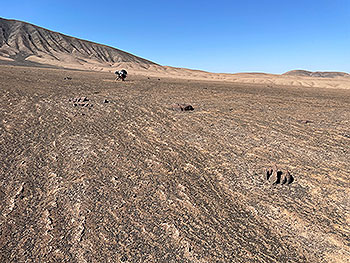After an involuntary break of field work due to the COVID-19 pandemic, subproject C2 successfully completed two extensive field campaigns during the last months. During the first one in February and March 2022, the project members visited together with colleagues from the Geological Survey of Namibia the remote northwest of the country. Later in May and June, another field campaign to the Atacama Desert in North Chile was carried out in collaboration with the Geological Survey of Chile (SERNAGEOMIN).
In both deserts, the main objective was to investigate and sample in a systematic manner the sediment deposits created during past periods of higher fluvial activity, with the overarching goal to derive the pre-Quaternary to Late Pleistocene fluvial landscape evolution along climate gradients and in comparison between the two hyperarid west-coast deserts.
Skeleton Coast, Namibia
Along the remote Skeleton Coast and Kunene Highlands in Northwest Namibia, Dr. Dominik Brill, Dr. Janek Walk and Julian Krieger conducted in total 6 weeks of field work in February and March in close cooperation with the Geological Survey of Namibia. Accompanied by Anna Nguno, deputy director and head of the Regional Geoscience Division, Andreas Nduutepo and Paulina Pokolo, the team focused on the fluvial fans stretching across the Skeleton Coast. Field work included screening and mapping of the fluvial landforms along a north-south gradient, their drainage basins, as well as their interaction with the Skeleton Coast Erg (Figure 1).
|
|
Selected sites, with catchments incised differently far into the more humid hinterlands to the east, were then studied in detail for dating using various methods. Accordingly, surfaces of seven multi-phase alluvial fans were sampled for cosmogenic nuclide surface exposure dating, while at six sites, fluvial deposits, often intercalated with aeolian sediments, were sampled for luminescence dating and in some cases also for palaeomagnetic dating (Figure 2).
|
|
Atacama Desert, Chile
Four weeks of field work in the Atacama Desert in May and June, conducted by Prof. Frank Lehmkuhl, Dr. Janek Walk, and Prof. em. Helmut Brückner, together with geologist Andrés Quezada from the SERNAGEOMIN, focused on small- to medium-sized alluvial fan systems aligned along a meridional transect from the slightly more humid Great Coastal Escarpment across the Salar Grande and the hyperarid core of the Atacama towards a mountain range at the Quebrada de Maní. Along this transect, five sites were systematically studied and fan surfaces sampled for cosmogenic nuclide surface exposure dating (Figure 3). For cross-check dating, also tephra was sampled, if present.
In addition, the group worked at the shore of the Salar Grande, where clastic material covers the salt succession. Andrés Quezada, expert for Salar Grande and surrounding geology, discussed with us the salar’s evolution (Figure 4) and supported us in sampling the rhythmic stratification of fluvial and alluvial deposits for luminescence and palaeomagnetic dating (Video).
|
|
|
Video: Sampling the clastic sediments and salt at the Salina Río Seco | Video: Frank Lehmkuhl |
At the coast of the CRC’s southern focus area, we further worked on the coastal alluvial fan Paposo – a site investigated and sampled in detail already during the first phase of the CRC. In collaboration with project C08, we took soil samples to be analysed for their micromorphological properties as well as for the new luminescence-based process tracing methods of the – at Paposo – biologically active Earth Critical Zone (see also: Z2/Z3/C8 joint fieldwork in March 2022)



























